Hildesheim Cathedral
| Hildesheim Cathedral Hildesheimer Dom | |
|---|---|
|
The cathedral with the prominent westwork, which was restored to a Romanesque appearance when it was rebuilt after the destruction in World War II | |
| 52°08′56″N 9°56′50″E / 52.14889°N 9.94722°ECoordinates: 52°08′56″N 9°56′50″E / 52.14889°N 9.94722°E | |
| Location | Hildesheim, Germany |
| Denomination | Roman Catholic |
| History | |
| Dedication | Assumption of Mary |
| Architecture | |
| Style | Romanesque |
| Groundbreaking | 1110s |
| Administration | |
| Diocese | Diocese of Hildesheim |
| Official name | St. Mary's Cathedral and St. Michael's Church at Hildesheim |
| Type | Cultural |
| Criteria | i, ii, iii |
| Designated | 1985 (9th session) |
| Reference no. | 187 |
| Region | Europe and North America |
Hildesheim Cathedral (German: Hildesheimer Dom), officially the Cathedral of the Assumption of Mary (German: St. Mariä Himmelfahrt), is a medieval Catholic cathedral in Hildesheim, Germany, that has been on the UNESCO World Cultural Heritage list since 1985, together with the nearby St. Michael's Church.
The cathedral church was built between 1010 and 1020 in the Romanesque style. It follows a symmetrical plan with two apses, that is characteristic of Ottonian Romanesque architecture in Old Saxony. The cathedral's treasures include world-famous artworks, bronzeworks from the time of Bishop Bernward, Bernward Doors and Bernward Column, as well as two of the four notable Romanesque wheel chandeliers: the Hezilo chandelier and the Azelin chandelier.
After renovations and extensions in the 11th, 12th and 14th centuries, the cathedral was completely destroyed during an air raid on 22 March 1945, and rebuilt from 1950 to 1960. A thorough renovation of the cathedral began in 2010, including technical and conservation measures. Some of the cathedral's treasures have been shown further afield, including at an exhibition at New York's Metropolitan Museum of Art. The cathedral was reopened on 15 August 2014.
History
Construction
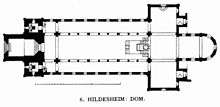
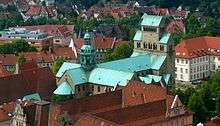
After the establishment of the diocese of Hildesheim in 815 by Louis the Pious,[1] a Chapel of St. Mary was built on the locations of the modern apse.[2] Bishop Gunthar of Hildesheim, who was in office from 815 to 834,[2] had a small basilica with two round towers built immediately to the south of the chapel, which he dedicated to Saint Cecilia. This served as the original cathedral and Stift church.[1] The first four bishops were buried there. Only traces of the foundations of these two buildings remain. An older Hildesheim parish church probably once stood on the site of the Chapel of Saint Stephen next to the gatehouse at the eastern entrance to the chapel of St. Hellweg, which might date back to Hildegrim of Châlons and his expedition to East Saxony.[3]
The Cathedral was built in 872 under Bishop Altfrid as a cruciform three-aisled basilica with a two-story westwork.[1] It is an example of Ottonian architecture, with alternating column support and semicircular apses completing the naves.[4] The building suffered severe fire damage in 1046.[2] Bishop Azelin planned to erect a new, larger building further to the west and to extend the nave. His successor, Hezilo of Hildesheim, abandoned this plan and instead built on the old foundations, incorporating the surviving walls into the new building. Further important renovations occurred up to the end of the fourteenth century, but did not deviate from the ground plan of Bishop Altfrid's basilica. The north and south side chapels date from the gothic period and the tower above the crossing from the baroque period. In the nineteenth century, the original westwork was replaced by a Neo-Romanesque two-tower facade, which stood until 1945.[1]
School and library
The Hildesheim Cathedral School (Hildesheimer Domschule, de), which had rooms in the cloisters, was one of the most significant educational institutions of the Ottonian and Salian periods. Its library has served as the Hildesheim Cathedral library (German: Dombibliothek Hildesheim) since 815; it is the oldest library in Northern Germany.[5]
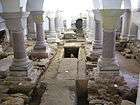 Foundation of the first cathedral under the crypt dating from 815
Foundation of the first cathedral under the crypt dating from 815- Crossing and northern side chapels
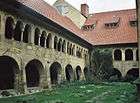 Cloister, built from 1060 to 1070
Cloister, built from 1060 to 1070 Cloister with St. Anne's Chapel, c. 1845
Cloister with St. Anne's Chapel, c. 1845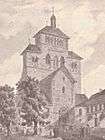 Westwork before 1840
Westwork before 1840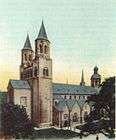 Neo-Romanesque westwork, 1890
Neo-Romanesque westwork, 1890 Anne's chapel
Anne's chapel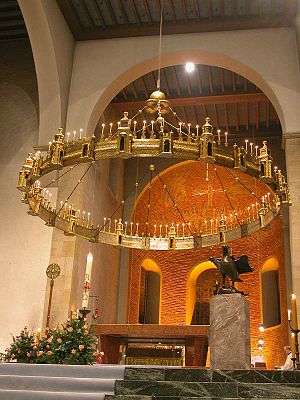 Hezilo chandelier in the crossing, 2009
Hezilo chandelier in the crossing, 2009
Destruction in the Second World War
During the aerial bombardment of Hildesheim by the RAF and RCAF in World War II, the main building was almost entirely destroyed; only the westwork and the outer walls survived.[1] Of the ancillary buildings, only the Gothic Anne's chapel (Annenkapelle), erected in 1321 in the middle of the cathedral's courtyard,[1] was mostly undamaged. It was the only cathedral in Germany that had to be newly consecrated after its reconstruction, on 27 March 1960 by Bishop Heinrich Maria Janssen.[1]
The building was rebuilt between 1950 and 1960 in a simplified form. The baroque elements were abandoned in favour of a form which took its cue from the early Romanesque style.[2] The most visible aspect of this on the exterior was that upper stories and side towers added to the westwork in 1840 were not restored and the westwork was reconstructed closer to its earlier state[6] based on the model of the westwork of Minden Cathedral.[7] In addition, the gatehouse in front of the westwork was reduced by about half. Otherwise, the exterior appeared as it had done before the destruction – in particular, the baroque crossing-tower was rebuilt.[7]
The reconstruction was carried out under tight constraints. Because of the lack of sandstone tiles, the floor was relaid in marble. The roofs of the nave, transept and cloisters were cast in concrete and covered with wooden boards on the inside to recall the appearance of ceiling beams. The interior walls, as well as the walls of the nave, were rebuilt in brick and limestone, hidden from view by a dimension stone coating on the outside and by a coat of smooth plaster on the inside. The ground level was raised by 60 cm, which resulted in the rooms having a squat appearance, especially in the transepts. The columns of the nave were cast in concrete and the pilasters were coated in sandstone.[7]
The reconsecration took until 1960 to complete because of various problems, chiefly the "Hildesheim Cathedral construction dispute" (Hildesheimer Dombaustreit), an argument between the Diocese of Hildesheim and the Land of Lower Saxony about the cost of the reconstruction and particularly about whether Lower Saxony was one of the legal successors of the Free State of Prussia which had undertaken to cover the cathedral's building expenses in 1803 (when it was still the Kingdom of Prussia) during the process of German mediatization. The parties reached a settlement in 1957.[7]
Renovations 2010–2014
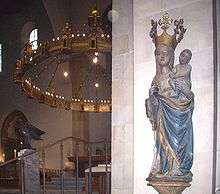
After many years of planning, a thorough renovation of the cathedral began in January 2010, the first since 1960. Along with technical and conservation measures, there were alterations to the design . The floor was lowered to the original level, the Hezilo and Azelin chandeliers were restored to their places in the nave and the high choir, and Bernward Doors were again mounted facing outwards, behind an antechamber, as originally intended. In addition, a bishop's crypt was created.[8]
On 10 January 2010 the cathedral was closed for the work to begin. During the reconstruction, the basilica of St. Godehard served as the bishop's church (cathedra), as it had in the postwar years. The cathedral renovation was the largest church construction project in Germany. The solemn reopening of the cathedral was on 15 August 2014, coinciding with the beginning of the Diocese's 1200 year jubilee.[8]
Thousand-year Rose

The cathedral building is widely known for the "Thousand-year Rose" (Tausendjähriger Rosenstock) which grows outside the building on the outer wall of the apse in the courtyard of the cloisters. The exact age of the rose is no longer precisely known, but the legend of the rosebush claims that it dates to 815. It is an important symbol of Hildesheim - according to folklore, as long as the bush flourishes, Hildesheim will prosper.[9]
According to the story, Emperor Louis the Pious had to hold a Mass while out hunting in the middle of the forest. For this purpose, a reliquary of St. Mary which he had with him was hung from the branch of a wild rose. After the mass, the reliquary could not be removed from the branch. The Emperor considered this a sign that the new bishopric should be established here (not in Elze as he had planned) and he should dedicate it to St. Mary, whose symbol is the rose.[9]
The existence of the rosebush has been attested for at least four hundred years. The aerial bombardment of 22 March 1945 which damaged the cathedral and the apse also killed the main growth of the rosebush above the ground; under the rubble, only the charred stump of the rose remained. It was thought that the end of the famous rose had come, but the roots were largely intact, and in the spring of 1945 it put out 25 new shoots.[9] The first sparse flowers bloomed in 1947, and by 1948 there were 122 flowers. Since then, the new branches of the "Thousand-year Rose" (as it was already known before the bombing) have been marked with little metal signs with the year in which they first appeared. It is believed to be the oldest living rose in the world.[10]
Archaeological finds
In excavations during the 2010-2014 renovations of the cathedral, ninth-century foundations of the St. Mary's chapel were found.[11] The first cathedral building was a small church measuring 6 x 6 m with an apse to the east. The remains of the first altar were found in the apse. The foundations of this first cathedral building consist of sandstone and are extraordinarily thick.[12]
An even older cemetery was found to the west and south. Twenty graves were uncovered, including, in August 2012, the skeleton of a young woman who died around 800, with glass beads (the remnants of a necklace) and a little knife as grave goods. This is the oldest complete burial ever found in Hildesheim cathedral.[13]

Excavations in the westwork 
Grave from around 800
Interior decoration, art, and treasures

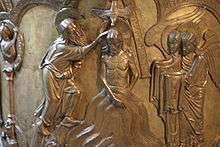

The cathedral houses numerous works of art. These include the world-famous cast-bronze doors, depicting scenes from the Gospels and the Book of Genesis; and a cast-bronze column depicting scenes from the life of Christ. These bronzeworks date from the early 11th century and were commissioned by Bishop Bernward of Hildesheim.[2] (The column was originally in St Michael's, where Bernward was buried, and has been moved there again during the restoration of the cathedral, possibly to stay.)[14]
There are also four notable Romanesque wheel chandeliers, also called corona or circular chandeliers,[15][16] the larger Hezilo chandelier (Heziloleuchter),[12][16] and the older Azelin chandelier (Azelinleuchter).[16] The Ringelheim Crucifix was made c. 1000 from linden wood for the body and oak for the arms.[17]
Other treasures include:[2]
- The shrine of St. Epiphanius of Pavia and Cathedral patrons under the high altar, first half of the twelfth century
- The shrine of St. Godehard in the crypt, around 1140
- The Hildesheim Reliquary of Mary, the Crosses of Bernward and further magnificent reliquaries and liturgical implements displayed in the Hildesheim Cathedral Museum (Dommuseum Hildesheim) in the south transept
- The eagle lectern, c.1220, in liturgical use up until the recent renovations
- The late Romanesque bronze baptismal font (Bronzetaufe), 1225.
- The gothic Inkpot Madonna (Tintenfassmadonna)
- The central table of the Wrisberg epitaph (in the south transept until the recent renovations)
- Notable among the post-war furnishings are Mary's window in the high choir (Mary with the Earth and Stars after Revelation 12:1) and the apse mosaic, which recalls both the destruction of Hildesheim in the war and the apocalypse, with words from Psalms 104:30 underneath Renovabis faciem terrae, alleluia (You will renew the face of the Earth, allelujah!)
- A statue of Mary standing in one of the side aisles of the nave, the pedestal of which, legend has it, was made from the core of the Irminsul
- the Tomb of Priest Bruno (de) on the southern exterior wall of the choir
- The Bernward Monument (de) of Carl Ferdinand Hartzer from 1893 stands in front of the northwest entrance
- The Hildesheim rood screen (Hildesheimer Domlettner, de) in St. Anthony's Church (deconsecrated on 17 September 2009) on the south side of the cloisters houses
During the 2010-2014 renovations, many religious items from the Cathedral were displayed at the Metropolitan Museum of Art in New York, until 5 January 2014.[18][19]
- Bronze baptismal font
- Shrine of St. Epiphanius
- Statue of Bishop Godehard
Organ
The history of the organ in Hildesheim Cathedral goes back to the fourteenth century. By 1378 there was an organ in the north aisle, above the chapel of the Three Kings. This instrument was moved to the Godehard choir in the fifteenth century and was sold in 1713.
The first large cathedral organ was built by master organ-builder Conrad Abtt (Minden), probably in 1616/7. The instrument had 31 registers in two manuals and pedals. Over the course of time the instrument was repeatedly rebuilt, expanded, and extended, especially at the end of the seventeenth and beginning of the eighteenth centuries. A complete rebuild by the organ-builders Furtwängler & Hammer (Hannover) in 1909, after which the organ had 54 registers in three manuals and pedals, is particularly important. Its original appearance remained largely intact through the course of all these renovations, but on 22 March 1945 the organ was destroyed in the air raid on Hildesheim.
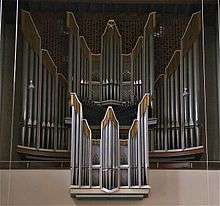
Cathedral organ of 1960/1989 (until 2010)
During the restoration of the cathedral, the organ builder Franz Breil (Dorsten) built a new organ with 52 registers in four manuals. The instrument was completed in 1960. As well as the usual works (main organ, chair organ, choir organ and pedals), this organ included a unique feature - a Spanish reed organ with three registers, which could be played from the fourth manual.[20]
Breil's organ proved insufficiently sonorous, so in 1989 it was rebuilt using new techniques and expanded to 66 registers by the organ firm Klais (Bonn). By arrangement with the heritage society, the organ's appearance, which reflected the stylistic fashions of the 1950s and 60s, was retained, as were the pipes and housing.[20]
New cathedral organ (from 2015)
In the course of the renovations, the organ firm Seifert (Kevelaer) are constructing a new cathedral organ system from the existing organ, consisting of a main organ and a choir organ. The system should be complete for the diocese's 1200th jubilee in 2015. The main organ was dismantled in February 2010 to make way for this new organ.[21]
The new main organ should have 77 registers in five manuals (able to be played at a four manual console) and pedals. The 56 registers and the windchests of the old organ will be reused. Since the choir and organ gallery were demolished during the renovation, the new main organ's appearance will be modified and it will be adjusted to suit the new acoustic environment.[21]
A new choir organ will be built in the nave for the accompaniment of the choir, which will henceforth be in the front portion of the cathedral. The slider chest organ will have 20 registers (including a half-draw register in its main organ, as well as two borrowed stops and a derived quint in the pedal) in two manuals and a pedal. The choir organ will be capable of being played along with the main organ.[21]
Bells

Until the Second World War, the cathedral contained over sixteen ringing and quarter bells. The basis of the pre-war peal was five great bells with the tones F-sharp0, A0, C-sharp1, F-sharp1, G-sharp1. Nine bells of the pre-war peal survived the war; the great Godehard bell in the west tower was so severely damaged in an air raid that it could no longer be rung. The Bernard bell is in the Bell cemetery in Hamburg and was irreparably damaged during transport there. Two bells were capable of being reused: the historical Apostolica bell of bellfounder Johann Martin Roth of Mainz (1765), which could be integrated into the new peal, and another historic bell of Johann Martin Roth, the Nikolaus bell, which was originally hung in the crossing tower and was moved to the Nordparadies in 2010.[22]
Refounding of 1960
After the Second World War it was planned to create a 12-toned peal, with six great bells in the west tower and six smaller bells in the crossing tower (the planned tones: G1, B-flat1, C2, E-flat2, F2 and G2). At first only a six tone peal was produced. In 1960 the bellfounder Friedrich Wilhelm Schilling (Heidelberg) cast five new bells, which were installed in the west tower together with the Apostolica bell. In the lower belfry of the tower hung the three deepest bells (1-3), while the three smaller bells (4–6) were in the upper belfry. The new peal (co-ordinated with the bells of the surrounding churches) was a semitone deeper than the original, so the Apostolica bell had to be tuned a semitone lower to fit with the new bells.[22]
Since the quarter bells had also been destroyed in the Second World War, the quarter-hour chimes were now struck by bell No. 5, the chime on the hour by bell No.4 and the chime at noon by bell No. 1. Bell No. 6 was used for the call to worship (the Angelusglocke).[22]
Renovation 2013/2014
In the course of the 2010-14 renovation, the peal is being expanded by six bells to the 12-tone peal which had originally been planned in the 1960s, though, the tone sequence will be slightly different.[23] The new cathedral bells will be named after witnesses of the faith, who enjoy particular veneration in the Diocese of Hildesheim. Thus bell No. 8 will be named for Bishop Altfrid, one of the most important bishops of Hildesheim, who secured large contributions for the construction of the Cathedral. Bell No. 9 will be named after Hedwig of Schlesien (or of Andechs), patron of refugees - since many refugees came to Hildesheim after the Second World War and were crucial in shaping it.[23]
In 2013 the old yoke in the upper belfry was taken apart and replaced by a new yoke of oak. It will hold the six new bells and some of the old ones. In the lower belfry the deepest bells will remain in place.[24]
On 16 November 2013 the new bells were cast by Glockengießerei Bachert (Karlsruhe).[25]
| Technical information and inscriptions of the bells | |||||||
|---|---|---|---|---|---|---|---|
| No. | Name | Year of casting | Caster, casting location | Ø (mm) |
Weight (kg) |
Strike tone (ST-1/16) |
Inscription |
| 1 | Cantabona | 1960 | Friedrich Wilhelm Schilling, Heidelberg | 2300 | 8686 | f0 +4 | CANTATE DOMINO CANTICUM NOVUM QUIA MIRABILIA FECIT SANCTA MARIA CANTA BONA NOBIS! – Auxilio Matris D.N.J.Ch. confidens me fudit F.W. Schilling Heidelbergensis Anno Domini MCMLIX ("Sing for the Lord a new song since he has made miracles. Holy Mary sing good things for us! - trusting in the aid of the mother of our Lord Jesus Christ, F.W. Schillung of Heidelberg cast me in the year of our Lord 1969.") |
| 2 | Apostolica | 1765 | Johann Martin Roth, Mainz | 1940 | 4895 | as0 +6 | Johann Martin Koch von Maintz hat mich gegossen in Hildesheim Anno 1765, APOSTOLIS PETRO ET PAULO COMPATRONIS HILDESIENSIBUS ("Johann Martin Koch of Mainz cast me in Hildesheim in the year 1765, for the Apostles Peter and Paul, joint-patrons of Hildesheim.") |
| 3 | Bernward | 1960 | Friedrich Wilhelm Schilling, Heidelberg | 1698 | 3366 | b0 +4 | SIT PIA PAX ET VOS AMEN CANITE SANCTE BERNWARDE ORA PRO NOBIS0 ("May there be holy peace. Sing "Amen"! Saint Bernward, plead for us") |
| 4 | Godehard | 1500 | 2278 | c1 +4 | STERNE RESISTENTES/STANTES REGE/TOLLE JACENTES. SANCTE GODEHARDE ORA PRO NOBIS ("Otherthrow the resisters/ rule the upstanding/ lift up the downcast. Saint Godehard plead for us") | ||
| 5 | Epiphanius | 1260 | 1343 | es1 +6 | EPIPHANIUS PACIFICATOR PATRONUS EPIPHANIAM DOMINI NUNTIAT. SANCTE EPIPHANI PRECARE PRO NOBIS ("Epiphanius the peacemaker and patron announces the epiphany of the Lord. Saint Epiphanius, pray for us") | ||
| 6 | Cäcilia | 1060 | 1068 | f1 +4 | CANTANTIBUS ORGANIS CAECILIA DOMINO DECANTABAT! SANCTA CAECILIA ADJUVA NOS ("while the organs sing, Caecilia sings to the Lord! Holy Caecilia, aid us") | ||
| 7 | Martin of Tours | 2013 | Bachert, Karlsruhe | g1 | HIC EST FRATRUM AMATOR + QUI MULTUM ORAT PRO POPULO SANCTE MARTINE + ORA PRO NOBIS ("He who pleads a lot for the people, loves his brothers Holy Martin, plead for us!") | ||
| 8 | Altfrid | as1 | INTERCESSIONE SANCTI EPISCOPI ALTFRIDI SUFFULTA + DIOECESIS NOSTRA FIRMA IN FIDE MANEAT ("Supported by the intercession of Holy Bishop Altfrid, may our diocese remain firm in its faith") | ||||
| 9 | Hedwig | b1 | BEATAE HEDVIGIS INTERCESSIO TRIBUAT POPULIS POLONIAE ET GERMANIAE CAELESTE SUBSIDIUM ("The intercession of blessed Hedwig grants the support of Heaven to the people of Poland and Germany") | ||||
| 10 | Oliver Plunkett | c2 | PROBASTI NOS + DEUS + ET EDUXISTI NOS IN REFRIGERIUM SANCTUS OLIVERUS PLUNKETT + RECONCILIATIONIS EXEMPLUM + EPISCOPUS ET MARTYR + ADIUVET NOS (You have tested us, God, and you have brought us to consolation. May holy Oliver Plunkett, example of reconciliation, Bishop and martyr, aid us") | ||||
| 11 | Niels Stensen | es2 | PULCHRA QUAE VIDENTUR + PULCHRIORA QUAE SCIUNTUR + LONGE PULCHERRIMA QUAE IGNORANTUR BEATE NICOLAE STENSEN + ORA PRO NOBIS ("What is seen is beautiful, what is known is more beautiful, what is unknown is most beautiful by far. Blessed Nicholas Stensen, plead for us") | ||||
| 12 | Edith Stein | f2 | CRUX EXALTATUR + UT CAELUM OSTENDAT SANCTA TERESIA BENEDICTA A CRUCE + ORA PRO NOBIS ("The cross is raised up to touch the heavens. Holy Teresa blessed by the cross, plead for us") | ||||
| – | Nikolaus | 1766 | Johann Martin Roth, Mainz | 950 | 550 | as1 +2 | |
World Heritage Site
Hildesheim Cathedral was declared a World Heritage Site by UNESCO in 1985.[26]
Reopening
On 15 August 2014, the cathedral was reopened after restoration. Bishop Norbert Trelle opened the Bernward doors and entered the cathedral, followed by 30 other bishops and guests including the Protestant bishop Christoph Meyns, Robert Zollitsch, Stephan Weil and Christian Wulff. Trelle said in his sermon: "Die Kirche muss auf die Zukunft hin leben, so wie sie aus der Vergangenheit heraus lebt." (The church has to live towards a future, as it lives from by the past). He added, regarding the situation in Syria: "Während wir hier einen Dom wiedereröffnen, brennen dort die Kirchen." (While we reopen a cathedral here, churches are burnt there). The cathedral was restored to an appearance closer to the original building, for example a ceiling inserted after World War II was removed, and the original floor level restored. A new altar was created by Ulrich Rückriem.[27][28]
Bibliography
- Brandt, Michael (2009), Bernwards Säule – Schätze aus dem Dom zu Hildesheim (in German), Regensburg: Schnell & Steiner, ISBN 978-3-7954-2046-8.
- ——— (2010), Bernwards Tür – Schätze aus dem Dom zu Hildesheim (in German), Regensburg: Schnell & Steiner, ISBN 978-3-7954-2045-1.
- Gallistl, Bernhard (2007–2008), "In Faciem Angelici Templi. Kultgeschichtliche Bemerkungen zu Inschrift und ursprünglicher Platzierung der Bernwardstür", Jahrbuch für Geschichte und Kunst im Bistum Hildesheim (in German), 75–76: 59–92, ISSN 0341-9975.
- ——— (2000), Der Dom zu Hildesheim und sein Weltkulturerbe, Bernwardstür und Christussäule (in German), Hildesheim: Bernward Mediengesellschaft, ISBN 3-89366-500-5.
- Heise, Karin (1998), Der Lettner des Hildesheimer Doms – Die Bildhauerkunst der Münsterschen Werkstätten 1535–1560, Der Hildesheimer Dom – Studien und Quellen (in German), 2,1 + 2,2, Hildesheim, 2 volumes.
- Claudia Höhl. Das Taufbecken des Wilbernus – Schätze aus dem Dom zu Hildesheim", Verlag Schnell & Steiner GmbH, Regensburg 2009, ISBN 978-3-7954-2047-5.
- Ulrich Knapp (ed.), EGO SUM HILDENSEMENSIS – Bischof, Domkapitel und Dom in Hildesheim 815 bis 1810, (Kataloge des Dom-Museums Hildesheim; Bd. 3), Michael Imhof Verlag, Petersberg (2000), ISBN 3-932526-74-0.
- Karl Bernhard Kruse (ed.), Der Hildesheimer Dom – Von der Kaiserkapelle und den Karolingischen Kathedralkirchen bis zur Zerstörung 1945 (Grabungen und Bauuntersuchungen auf dem Domhügel 1988 bis 1999), Verlag Hahnsche Buchhandlung, Hannover (2000), ISBN 3-7752-5644-X.
- Annett Laube-Rosenpflanzer & Lutz Rosenpflanzer. Kirchen, Klöster, Königshöfe : vorromanische Architektur zwischen Weser und Elbe, Halle 2007, ISBN 3-89812-499-1.
References
- 1 2 3 4 5 6 7 Architecture of the Cathedral – A Chronological overview, DE: Domsanierung, retrieved 30 April 2014.
- 1 2 3 4 5 6 Barnet, Peter; Brandt, Michael; Lutz, Gerhard (2013), Medieval Treasures from Hildesheim, Yale University Press.
- ↑ Gallistl, Bernhard (2000), Epiphanius von Pavia, Schutzheiliger des Bistums Hildesheim, Hildesheim und Bielefeld, p. 68.
- ↑ Jeep, John M. (2001). Medieval Germany: An Encyclopedia. Psychology Press.
- ↑ Gallistl, Bernhard (2010), "Bibliothek und Schule am Dom", in Müller, Monika E, Schätze im Himmel – Bücher auf Erden. Mittelalterliche Handschriften aus Hildesheim, catalogues of the Herzog August Bibliothek (in German) (93), Wiesbaden: Harrassowitz, pp. 55–68, ISBN 978-3-447-06381-4.
- ↑ The Grove Encyclopedia of Medieval Art and Architecture, 2, Oxford University Press, 2012, ISBN 0-19-539536-0.
- 1 2 3 4 Knapp, Ulrich, ed. (1999), Der Hildesheimer Dom – Zerstörung und Wiederaufbau, catalogue of the Dom-Museum Hildesheim, 2, Petersberg: Michael Imhof, ISBN 3-932526-48-1.
- 1 2 Frequently asked questions concerning cathedral restoration, Domsanierung, retrieved 3 May 2014.
- 1 2 3 1000 years of age rosetree (German) Domsanierung, retrieved 2 May 2014
- ↑ Hayes, Holly. "Hildesheim Cathedral". Sacred Destinations. Archived from the original on 30 April 2014. Retrieved 30 April 2014.
- ↑ Kehrwieder am Sonntag: Fund im Dom belegt - Hildesheim feiert zu Recht den 1200. Geburtstag. 29 May 2011, p. 6 (in German).
- 1 2 Hildesheim Cathedral – St. Mariä Himmelfahrt – is currently being restored. Medieval Histories
- ↑ Information from the diocese (German). Retrieved 21 August 2012.
- ↑ Bernward’s Column (Christ's Column) Domsanierung. Retrieved 30 April 2014
- ↑ Julia de Wolf Addison: Arts and Crafts in the Middle Ages Medieval Histories
- 1 2 3 Bernhard Gallistl: Bedeutung und Gebrauch der großen Lichterkrone im Hildesheimer Dom. In: Concilium Medii Aevi 12 (2009, table of content) p. 43–88 (PDF; 2,9 MB). Retrieved 2 May 2014
- ↑ Ringelheim Crucifix Metropolitan Museum of Art. Retrieved 2 May 2014
- ↑ Medieval Treasures from Hildesheim Metropolitan Museum of Art 2013
- ↑ Molly Lo Re: Met displays Medieval treasures from Hildesheim Cathedral Metropolitan Museum of Art Columbia Spectator, 24 September 2013
- 1 2 Information on the organ of 1960.
- 1 2 3 Information on the new organ system and on the disposition (PDF; 35 kB) of the new organ system. Retrieved 30 April 2014.
- 1 2 3 Information on the bells of HIldesheim cathedral. Retrieved 30 April 2014.
- 1 2 Information on the new bells.
- ↑ Information (PDF; 2,6 MB) from the diocese about the renovations.
- ↑ News report on the casting of the new bells for Hildesheim Cathedral.
- ↑ "St Mary's Cathedral and St Michael's Church at Hildesheim". World Heritage List. UNESCO. 1985. Retrieved 10 May 2014.
- ↑ "Hildesheimer Dom mit Festgottesdienst wiedereröffnet" (in German). dpa. 16 August 2014. Retrieved 16 August 2014.
- ↑ "Hildesheimer Dom kurz vor Wiedereröffnung" (in German). NDR. 8 August 2014. Retrieved 16 August 2014.
External links
| Wikimedia Commons has media related to St. Mary's Cathedral, Hildesheim. |
- More information about St. Mary's Cathedral (Hornemann Institut)
- Pictures (Raymond Faure's Website)
- Homepage of the Cathedral Museum (German)
- Video clips Two dozen short films covering the renovation work and archeological finds dating back to the Carolingian foundation including rare, well-preserved 12th-century textile remnants (from liturgical vestments of robed ecclesiastics as interred) (German)
- Sacred Destinations entry for Hildesheim Cathedral
- Bilder zur Ausstellung "Bernwards Schätze" im Dom-Museum Hildesheim images of the exhibition Bernwards Schätze (Bernward's Treasures) in Hannoversche Allgemeine, photo gallery (German)
- Hildesheim Cathedral’s Treasures – UNESCO World Heritage Site The Culture Concept, 2014
- Saint Bernward of Hildesheim: Medieval Patron of the Arts Reliquarian 2014
- Hildesheim Cathedral Worldarchitecturemap
- Reopening of Hildesheim Cathedral photo preview 51521988 epa.eu
- Hildesheim Cathedral pictures on sekulada.com (Polish)